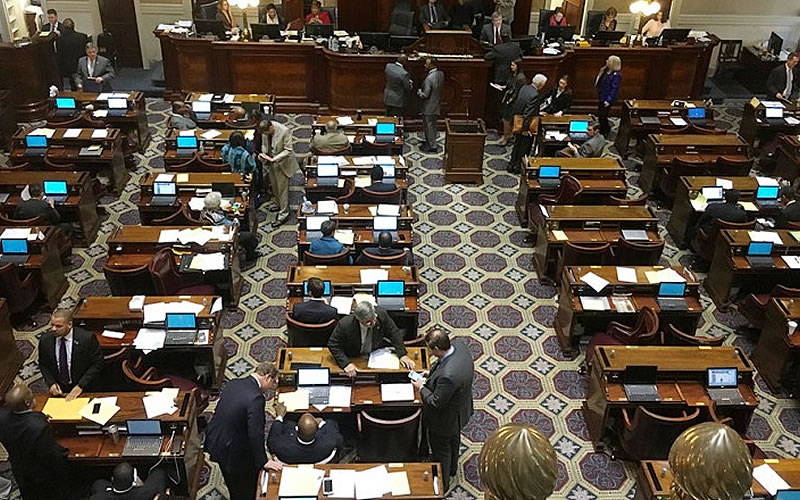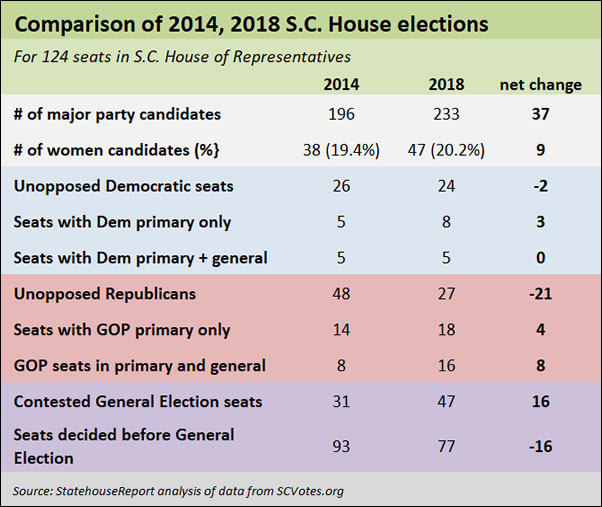
By Andy Brack, editor and publisher | It may be the Year of the Woman in politics around the nation, but not in South Carolina – at least not in races for the S.C. House of Representatives
In 2018, just over 20 percent of major party candidates in the 124 House races are women, according to a Statehouse Report analysis of state election data. Four years ago, there were nine fewer women candidates as 38 women (19.4 percent of candidates) ran for House seats.
College of Charleston political scientist Gibbs Knotts said he is surprised more women aren’t running for state House seats, particularly with a heightened energy by women about politics and organizing since President Trump was elected in 2016.
“South Carolina has the seventh lowest percentage of women state legislators in the country so there is certainly room for growth,” he said, noting a 2018 study by the Center for American Women in Politics at Rutgers University.
But he added that South Carolina’s traditional political culture as well as discrimination against women might be reasons more women aren’t running for the House here.

While the number of female candidates running in 2018 isn’t markedly different in House races, three things stand out:
Fewer unopposed Republicans. Four years ago, 48 Republican House candidates had no opposition in the primary or general election. This year, that number dropped almost in half to 27 unopposed candidates.
More contested GOP primaries. Fewer unopposed races, means more contested ones. In 2018, a dozen seats have GOP candidates who will face a primary or a primary plus a general election Democratic opponent. Why the change? More than likely, it’s because more conservative candidates emboldened by Trump are trying to drain the Statehouse swamp of already-conservative GOP House incumbents.
More contested races in November. The dynamics of politics this year reveal there will be fewer seats – 77 – decided before the general election, compared to three quarters of seats in 2014. That means voters have more choices in November. But it’s still a little disturbing that more than half of the seats don’t face general election competition, an indicator of gerrymandering at play.
“There’s a lot of interest in politics right now, thanks to Trump and some divisions within the Republican Party nationally and locally about the direction the party should go,” said Danielle Vinson, a political scientist at Furman University. “ Some of those pre-date Trump, but he has certainly exacerbated them. So, that may be driving some of the increased interest in running for office among Republicans and would explain the increase in the number of Republican incumbents facing primary challenges.”
She thought, however, some incumbents just seem to attract primary challengers, regardless of the political environment, or because they’re relatively new in office, which may draw challengers who smell weakness or opportunity.
“We learned in 2016 that incumbents can be vulnerable in primaries in South Carolina if they’ve taken controversial votes or missed a lot of votes,” Vinson said. “We lost a lot of incumbents that year.”
Knotts made a similar observation: “I suspect incumbents are being ‘primaried’ by more conservative candidates. There is probably a Trump effect taking place and there could be some backlash against the corruption probe in Columbia and the increased gas tax that was passed in 2017.”
If you’re a little miffed that 62 percent of House seats will be decided before the general election by members of one major party or the other, there are at least two options:
Run for office. The more people who run give more choices to voters, particularly in primaries. If the major parties disgust you, there are always third parties. Unfortunately, they currently fare so poorly that the state has no third-party elected officials.
Attack gerrymandering. The General Assembly will decide how House, Senate and congressional seats are drawn after the 2020 Census. If you want districts to be more competitive and reflective of how politics are in your area, you need to work or donate to organizations that want to defeat or alter the good-old-boy way districts are drawn.
Democracy is stronger when it is competitive. What we’re generally doing now is just protecting incumbents and encouraging the edges of politics, not promoting the common good.
- Have a comment? Send to: feedback@statehousereport.com.


